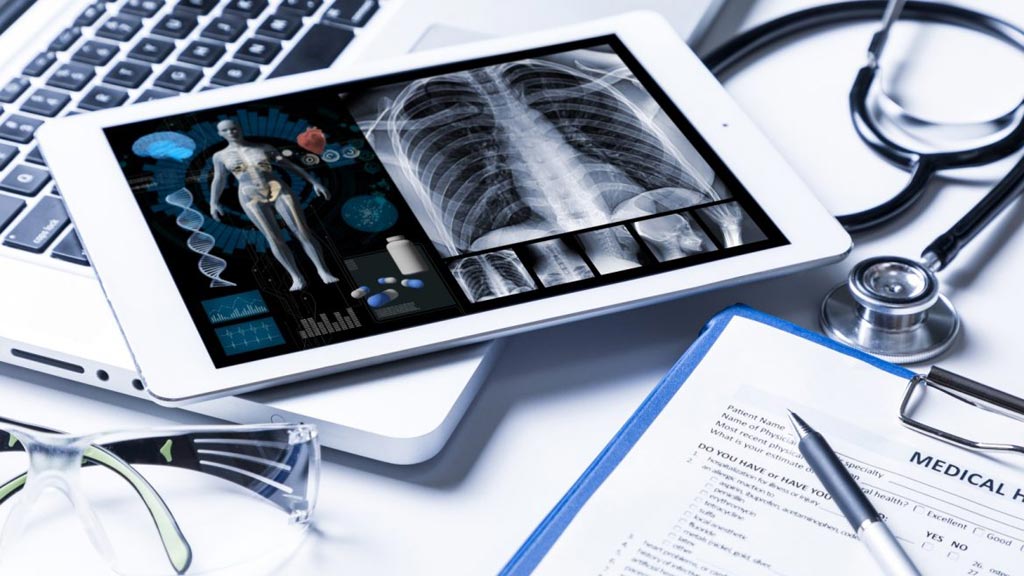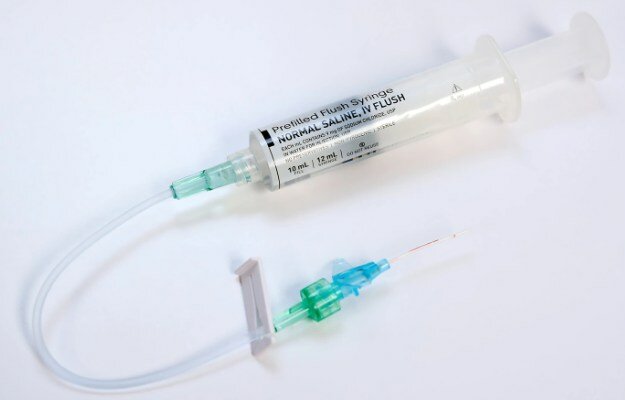Chest X-Rays of COVID-19 Patients Have High Likelihood of Predicting Positive RT-PCR Test Results
|
By HospiMedica International staff writers Posted on 16 Nov 2020 |

Illustration
A new analysis has revealed that using a structured approach for chest X-rays of suspected COVID-19 patients increases the possibility of predicting positive RT-PCR testing results and can be useful in identifying new cases of COVID-19.
Given the uncertainties surrounding the role and clinical utility of chest radiography in the early evaluation of patients with suspected COVID-19 pneumonia, researchers at the University College Dublin (Dublin, Ireland) carried out a study to construct a detailed description of a structured approach to reporting chest X-rays in patients with suspected COVID-19 pneumonia. The study also aimed to evaluate the diagnostic performance of chest radiography compared to RT-PCR.
The study involved 590 patients suspected of COVID-19 who had attended a hospital emergency department and underwent both a portable chest radiograph (CXR) and a RT-PCR test for presence of SARS-CoV-2 on initial assessment. Patients were suspected of COVID-19 if they presented with symptoms of an acute respiratory infection, (including fever, shortness of breath and cough) or a fever of unknown cause. Serial RT-PCR was completed if the initial result was negative, at intervals of one day or more, if deemed required by clinicians. For patients with multiple RT-PCR assays, a positive result on an assay within seven days of the initial swab was adopted as confirmation of diagnosis. Patients who had a positive RT-PCR more than seven days after their initial assay were excluded from analysis. Patients underwent a CXR if they were suspected of COVID-19 and had moderate to severe symptoms requiring admission for treatment.
The researchers found that found that using a COVID-specific structured approach to interpretation, a CXR designated as High Suspicion or Characteristic in a patient presenting to the emergency department with clinically suspected COVID-19 pneumonia correlated with a very high likelihood of a positive RT-PCR. The team recommends confirmation with RT-PCR but believes that the positive predictive value and specificity of a positive chest radiograph merit a presumptive diagnosis of COVID-19 until the RT-PCR result becomes available. Furthermore, the researchers suggest that if initial RT-PCR is negative, in those with a positive CXR, particularly those with a characteristic appearance, those precautions should still be maintained and RT-PCR repeated.
“We have demonstrated very good agreement in the application of this structured approach in a single institution and feel that this practice is generalizable to other institutions,” wrote the researchers. “CXRs that are designated as Normal, Unlikely or Indeterminate are less useful in the initial patient evaluation but awareness of this finding is essential for clinicians. Given that CT of the chest has shown high sensitivity but low specificity, radiographs and CT may be complementary tests in diagnostically difficult cases. Lastly, CXRs have been shown to be useful in prognostication and in tracking disease progression.”
Related Links:
University College Dublin
Given the uncertainties surrounding the role and clinical utility of chest radiography in the early evaluation of patients with suspected COVID-19 pneumonia, researchers at the University College Dublin (Dublin, Ireland) carried out a study to construct a detailed description of a structured approach to reporting chest X-rays in patients with suspected COVID-19 pneumonia. The study also aimed to evaluate the diagnostic performance of chest radiography compared to RT-PCR.
The study involved 590 patients suspected of COVID-19 who had attended a hospital emergency department and underwent both a portable chest radiograph (CXR) and a RT-PCR test for presence of SARS-CoV-2 on initial assessment. Patients were suspected of COVID-19 if they presented with symptoms of an acute respiratory infection, (including fever, shortness of breath and cough) or a fever of unknown cause. Serial RT-PCR was completed if the initial result was negative, at intervals of one day or more, if deemed required by clinicians. For patients with multiple RT-PCR assays, a positive result on an assay within seven days of the initial swab was adopted as confirmation of diagnosis. Patients who had a positive RT-PCR more than seven days after their initial assay were excluded from analysis. Patients underwent a CXR if they were suspected of COVID-19 and had moderate to severe symptoms requiring admission for treatment.
The researchers found that found that using a COVID-specific structured approach to interpretation, a CXR designated as High Suspicion or Characteristic in a patient presenting to the emergency department with clinically suspected COVID-19 pneumonia correlated with a very high likelihood of a positive RT-PCR. The team recommends confirmation with RT-PCR but believes that the positive predictive value and specificity of a positive chest radiograph merit a presumptive diagnosis of COVID-19 until the RT-PCR result becomes available. Furthermore, the researchers suggest that if initial RT-PCR is negative, in those with a positive CXR, particularly those with a characteristic appearance, those precautions should still be maintained and RT-PCR repeated.
“We have demonstrated very good agreement in the application of this structured approach in a single institution and feel that this practice is generalizable to other institutions,” wrote the researchers. “CXRs that are designated as Normal, Unlikely or Indeterminate are less useful in the initial patient evaluation but awareness of this finding is essential for clinicians. Given that CT of the chest has shown high sensitivity but low specificity, radiographs and CT may be complementary tests in diagnostically difficult cases. Lastly, CXRs have been shown to be useful in prognostication and in tracking disease progression.”
Related Links:
University College Dublin
Latest COVID-19 News
- Low-Cost System Detects SARS-CoV-2 Virus in Hospital Air Using High-Tech Bubbles
- World's First Inhalable COVID-19 Vaccine Approved in China
- COVID-19 Vaccine Patch Fights SARS-CoV-2 Variants Better than Needles
- Blood Viscosity Testing Can Predict Risk of Death in Hospitalized COVID-19 Patients
- ‘Covid Computer’ Uses AI to Detect COVID-19 from Chest CT Scans
- MRI Lung-Imaging Technique Shows Cause of Long-COVID Symptoms
- Chest CT Scans of COVID-19 Patients Could Help Distinguish Between SARS-CoV-2 Variants
- Specialized MRI Detects Lung Abnormalities in Non-Hospitalized Long COVID Patients
- AI Algorithm Identifies Hospitalized Patients at Highest Risk of Dying From COVID-19
- Sweat Sensor Detects Key Biomarkers That Provide Early Warning of COVID-19 and Flu
- Study Assesses Impact of COVID-19 on Ventilation/Perfusion Scintigraphy
- CT Imaging Study Finds Vaccination Reduces Risk of COVID-19 Associated Pulmonary Embolism
- Third Day in Hospital a ‘Tipping Point’ in Severity of COVID-19 Pneumonia
- Longer Interval Between COVID-19 Vaccines Generates Up to Nine Times as Many Antibodies
- AI Model for Monitoring COVID-19 Predicts Mortality Within First 30 Days of Admission
- AI Predicts COVID Prognosis at Near-Expert Level Based Off CT Scans
Channels
Critical Care
view channel
Light-Based Technology to Measure Brain Blood Flow Could Diagnose Stroke and TBI
Monitoring blood flow in the brain is crucial for diagnosing and treating neurological conditions such as stroke, traumatic brain injury (TBI), and vascular dementia. However, current imaging methods like... Read more
AI Heart Attack Risk Assessment Tool Outperforms Existing Methods
For decades, doctors have relied on standardized scoring systems to assess patients with the most common type of heart attack—non-ST-elevation acute coronary syndrome (NSTE-ACS). The GRACE score, used... Read moreSurgical Techniques
view channel
Minimally Invasive Endoscopic Surgery Improves Severe Stroke Outcomes
Intracerebral hemorrhage, a type of stroke caused by bleeding deep within the brain, remains one of the most challenging neurological emergencies to treat. Accounting for about 15% of all strokes, it carries... Read more
Novel Glue Prevents Complications After Breast Cancer Surgery
Seroma and prolonged lymphorrhea are among the most common complications following axillary lymphadenectomy in breast cancer patients. These postoperative issues can delay recovery and postpone the start... Read morePatient Care
view channel
Revolutionary Automatic IV-Line Flushing Device to Enhance Infusion Care
More than 80% of in-hospital patients receive intravenous (IV) therapy. Every dose of IV medicine delivered in a small volume (<250 mL) infusion bag should be followed by subsequent flushing to ensure... Read more
VR Training Tool Combats Contamination of Portable Medical Equipment
Healthcare-associated infections (HAIs) impact one in every 31 patients, cause nearly 100,000 deaths each year, and cost USD 28.4 billion in direct medical expenses. Notably, up to 75% of these infections... Read more
Portable Biosensor Platform to Reduce Hospital-Acquired Infections
Approximately 4 million patients in the European Union acquire healthcare-associated infections (HAIs) or nosocomial infections each year, with around 37,000 deaths directly resulting from these infections,... Read moreFirst-Of-Its-Kind Portable Germicidal Light Technology Disinfects High-Touch Clinical Surfaces in Seconds
Reducing healthcare-acquired infections (HAIs) remains a pressing issue within global healthcare systems. In the United States alone, 1.7 million patients contract HAIs annually, leading to approximately... Read moreHealth IT
view channel
Printable Molecule-Selective Nanoparticles Enable Mass Production of Wearable Biosensors
The future of medicine is likely to focus on the personalization of healthcare—understanding exactly what an individual requires and delivering the appropriate combination of nutrients, metabolites, and... Read moreBusiness
view channel
Philips and Masimo Partner to Advance Patient Monitoring Measurement Technologies
Royal Philips (Amsterdam, Netherlands) and Masimo (Irvine, California, USA) have renewed their multi-year strategic collaboration, combining Philips’ expertise in patient monitoring with Masimo’s noninvasive... Read more
B. Braun Acquires Digital Microsurgery Company True Digital Surgery
The high-end microsurgery market in neurosurgery, spine, and ENT is undergoing a significant transformation. Traditional analog microscopes are giving way to digital exoscopes, which provide improved visualization,... Read more
CMEF 2025 to Promote Holistic and High-Quality Development of Medical and Health Industry
The 92nd China International Medical Equipment Fair (CMEF 2025) Autumn Exhibition is scheduled to be held from September 26 to 29 at the China Import and Export Fair Complex (Canton Fair Complex) in Guangzhou.... Read more

















